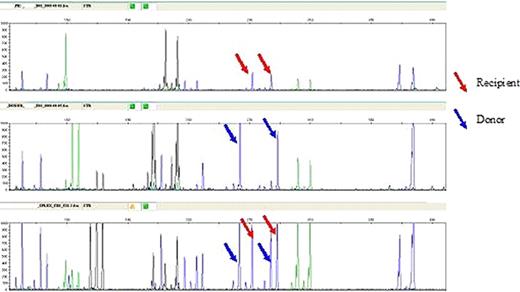Abstract
Abstract 4556
Purine nucleoside phosphorylase (PNP) deficiency and Adenosine deaminase (ADA) deficiency are two genetic disorders that, manifest as severe combined immunodeficiency. Both disorders are characterized by recurrent infections, failure to thrive and neurologic deficits. Therapeutic options for ADA deficiency include enzyme replacement therapy (ERT) and while bone marrow transplant (BMT) is “curative” for both the conditions, it is held that even this procedure does not correct neurological deficits. We describe a boy who underwent BMT for PNP deficiency which not only resulted in freedom from infections but also autologous T cell recovery and neurological improvement. This 16 month old was referred with a history of recurrent infections since the age of 3 months associated with failure to thrive and delayed motor development. He had normal hemoglobin and platelets but a low leucocyte count of 2.6 ×109/L with lymphopoenia. Further testing showed low plasma uric acid, a complete absence of PNP activity in red cells and increased urine levels of inosine, guanosine and their deoxy forms, confirming PNP deficiency. In July 2008, the patient underwent matched unrelated donor (MUD) BMT. Post transplant he maintained a normal CD8 and low CD4 counts but never achieved B-cell engraftment. The majority of the T-cells in the peripheral blood were of donor origin, as would be expected, as he had no T-cells prior to the transplant. Unfortunately with time he lost the graft. He went on to have a second MUD BMT (same donor) in July 2010.
Now a year after the second transplant he has a normal B and T cells, including T subsets, he is not only free from infections but also has demonstrated improvement in his neurological symptoms. He has stable peripheral blood mixed chimerism, including presence of recipient T cells. The re-emergence of recipient T Cells – when there were virtually no such cells at presentation and prior to the first transplant – is indicative of correction of the T cell defect in the recipient immune system.
Both PNP and ADA are key enzymes in the purine salvage pathway and their lack allows intracellular accumulation of metabolites that are toxic to lymphoid cells. ERT with pegademase bovine (PEG-ADA) is one of the therapeutic options in ADA deficiency by affording metabolic detoxification of T cells. This is achieved by maintaining very high plasma ADA levels that leads to a reduction in extracellular adenosine and deoxyadenosine and subsequent normalization of intracellular levels through maintenance of equilibrium between the two compartments. But a major limitation of PEG-ADA is the inability to correct the neurological deficit.
In our patient, autologous T cell reconstitution is suggestive of donor cells providing the enzyme and thus leading to similar compartment shift of the metabolites. This allows “detoxification” of the recipient T cell, and thus in turn, their reconstitution. The improvement in neurological symptoms in our patient is not unprecedented and has been described by others post BMT. This probably is due cross correction of enzyme deficient tissue by engrafted donor leucocytes. This has also been seen in metabolic disorders such as Hurler syndrome where it is well recognized that ERT will not correct the neurological deterioration seen in this disease, however BMT does arrest the neurological deterioration.
These findings indicate that BMT may also act as an as an enzyme delivery system, and offer beneficial effects in neurological disease, thus further justifying the role of BMT in such disorders.
Top Graph: Total lymphocyte count and subsets over 2 years. Lower Graph: Chimerism data; post 1st transplant when total PBL chimerism dropped to about 30%, T cell chimerism (CD3) was still maintained at 90%, thus there is minimal autologous recovery. Post 2nd transplant, while PBL chimerism is near 60% (thus there are adequate cells to deliver the enzyme), CD3 chimerism is at 60%, indicating the remaining T cells being autologous. (TL total lymphocytes, PBL peripheral blood leucocytes)
Peripheral T Cell Chimerism: Top panel: Recipient microsatellite markers (MSM) pre-transplant. Middle panel: Donor MSM. Lower panel: Demonstrates mixed chimerism with presence of both the recipient and donor MSM. Of the 6 markers, FGA Marker highlighted as it gives the best clarity of the mixed chimerism in this case.
No relevant conflicts of interest to declare.
Author notes
Asterisk with author names denotes non-ASH members.



This feature is available to Subscribers Only
Sign In or Create an Account Close Modal